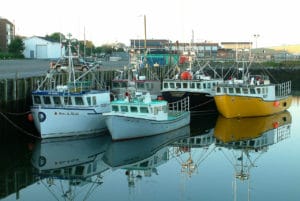Thousands of Nova Scotians fought in the American Civil War (1861–1865), primarily on behalf of the North. The British Empire (including Nova Scotia) declared itself neutral in the conflict. As a result, Britain (and Nova Scotia) continued to trade with both the South and the North. Nova Scotia’s economy boomed during the Civil War.

Soon after the American Civil War, Pro-Canadian Confederation premier Charles Tupper led Nova Scotia into the Canadian Confederation on 1 July 1867, along with New Brunswick and the Province of Canada. The Anti-Confederation Party was led by Joseph Howe. Almost three months later, in the election of 18 September 1867, the Anti-Confederation Party won 18 out of 19 federal seats, and 36 out of 38 seats in the provincial legislature.
Nova Scotia became a world leader in both building and owning wooden sailing ships in the second half of the 19th century. Nova Scotia produced internationally recognized shipbuilders Donald McKay and William Dawson Lawrence. The fame Nova Scotia achieved from sailors was assured when Joshua Slocum became the first man to sail single-handedly around the world. International attention continued into the following century with the many racing victories of the Bluenose schooner. Nova Scotia was also the birthplace and home of Samuel Cunard, a British shipping magnate (born at Halifax, Nova Scotia) who founded the Cunard Line.
Throughout the 19th century, numerous businesses developed in Nova Scotia became of pan-Canadian and international importance: the Starr Manufacturing Company (first skate-manufacturer in Canada), the Bank of Nova Scotia, Cunard Line, Alexander Keith’s Brewery, Morse’s Tea Company (first tea company in Canada), among others. Early in the 20th century Sobey’s was established, as was Maritime Life.
Economy:
Nova Scotia’s per capita GDP in 2010 was $38,475, significantly lower than the national average per capita GDP of $47,605 and a little more than half of Canada’s richest province, Alberta. GDP growth has lagged behind the rest of the country for at least the past decade.
Nova Scotia’s traditionally resource-based economy has diversified in recent decades. The rise of Nova Scotia as a viable jurisdiction in North America, historically, was driven by the ready availability of natural resources, especially the fish stocks off the Scotian Shelf. The fishery was a pillar of the economy since its development as part of New France in the 17th century; however, the fishery suffered a sharp decline due to overfishing in the late 20th century. The collapse of the cod stocks and the closure of this sector resulted in a loss of approximately 20,000 jobs in 1992.
Other sectors in the province were also hit hard, particularly during the last two decades: coal mining in Cape Breton and northern mainland Nova Scotia has virtually ceased, and a large steel mill in Sydney closed during the 1990s. More recently, the high value of the Canadian dollar relative to the US dollar has hurt the forestry industry, leading to the shutdown of a long-running pulp and paper mill near Liverpool. Mining, especially of gypsum and salt and to a lesser extent silica, peat and barite, is also a significant sector. Since 1991, offshore oil and gas has become an important part of the economy, although production and revenue are now declining. Agriculture remains an important sector in the province, particularly in the Annapolis Valley.
